
So in my previous posts on caravan servicing and caravan brakes, I briefly touched on the topic of caravan breakaway cables. Why they are important and why you should always fit one. However, at the time, I knew that I needed to write a separate post on caravan breakaway cables. Within the last few years, there has been a change to best practice standards. Not only in how you should fit the breakaway cable to your tow car but also the type of breakaway cables caravanners should be using. Most of our guests at Horton Common have a breakaway cable fitted to their caravan car, such as the one in the image below. However, this particular breakaway cable and others like it do not actually meet the new standard. Below I’ll discuss why that’s the case.
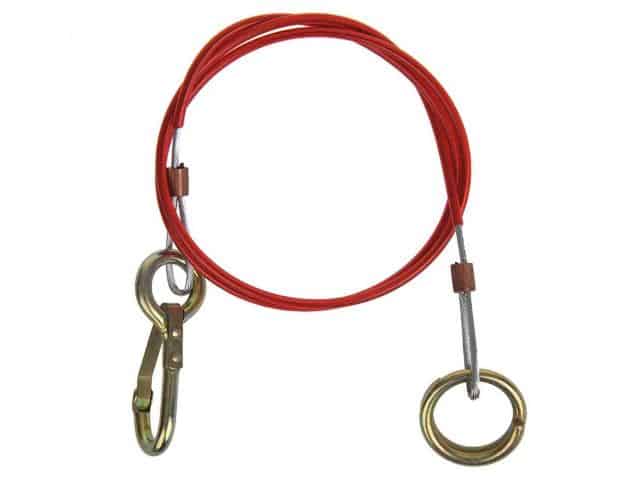
Disclaimer: Hey! By the way… any links on this page that lead to products on Amazon or Caravan Guard are affiliate links, and I earn a commission if you make a purchase, with no additional cost to you 🙂
- Dissolves waste and removes odours naturally and has delightful mild fragrance
If you’re new to caravanning, you may not be familiar with the caravan breakaway cable at all. If you’re an experienced caravanner, some of the information below may seem pretty obvious.
However, even for experienced caravanners, I would encourage you to watch the full video below on the latest standards on breakaway cables.
You can also use the Table of Contents below to jump to any particular section.
Want To Visit Horton Common? – Book Here
Table of Contents
Caravan Breakaway Cable New Standards
I only became aware of the latest standard on caravan breakaway cables after speaking with one of our guests.
They had recently purchased a new caravan, and the dealer made them aware of the change in standards. I then did a little bit of research myself, and I came across the video below from Caravan Guard.
Caravan Guard is one of the most popular insurers for leisure vehicles. Hence, its in their best interests to make caravanners aware of the latest safety standards.
However, its also in the best interest of the caravanner. While the new standards are not as of yet a change in the law, that might change in the future.
Hence, you don’t want to find out in the future after an accident your caravan insurance will not pay out due to a breakaway cable or fitment which is not to standard.
The Caravan Guard video above is presented by Tim Booth. Tim, as you can see from his T-shirt, is a member of the NPCC (National Police Chiefs’ Council) as a Leisure Vehicles Officer.
Hence, this isn’t just some random advice on breakaway cables from a self-proclaimed ‘caravan expert’.
Below I’m going to summarise the points made in the video above. I’ll also add a few comments of my own.
As previously stated, some of the information below is going to be ‘old hat’ to experienced caravanners. However, as always, its the little details which you may not be aware of which can provide value.
What Is A Breakaway Cable & Why Do You Need One?
The clue is in the name. Essentially if your caravan became unhitched from your car the breakaway cable engages the handbrake on your caravan.
The breakaway cable is designed to snap in such a scenario. As stated in the video, since 2018, all breakaway cables fitted to caravans should have a carabiner, not a spring clip.
Carabiner, Spring Clip, What’s The Difference?
Well, in the past, with a spring clip, there have apparently been incidents where the clip failed first and not the cable.
Hence, if the car and caravan become separated by the clip failing, the handbrake on the caravan is not engaged. Therefore, rendering the principle of the breakaway cable pointless.
With a carabiner and a proper mounting point, the cable should always snap and engage the handbrake.
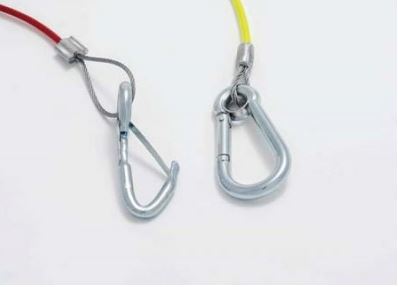
Properly Fitting A Breakaway Cable
Many caravanners today still have a spring clip breakaway cable. Eventually, all caravan breakaway cables will use a carabiner.
The information below, referencing Tim’s advice, covers both spring clips and carabiners.
The whole point of the new 2018 standard was to try and remove confusion. How and where should and shouldn’t you fit a caravan breakaway cable?
Therefore below, I’ve separated the advice based on the type of cable you may have on your caravan.
Fitting A Spring Clip Breakaway Cable
If you have a spring clip breakaway cable fitted to your caravan, you should only place it around the neck of your tow ball or through the tow hitch.
In other words, a spring clip breakaway cable should only attach back onto the cable itself.
You should never fit a spring clip breakaway cable to a clip mounting point on the car’s tow hitch. The reason is as discussed above.
In that scenario, the spring clip could fail before the cable engages the caravan handbrake. The following images below are the only safe means to attach a spring clip cable safely.
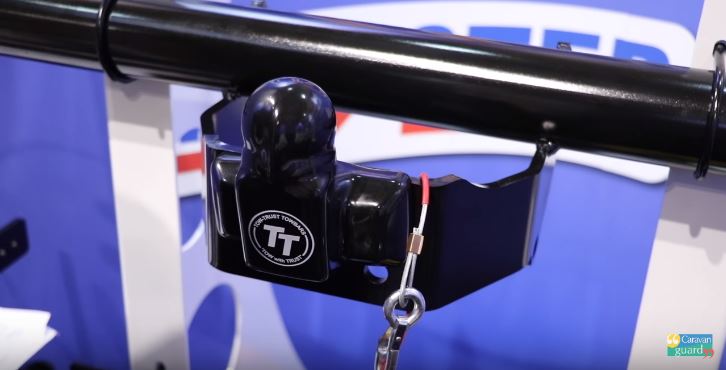
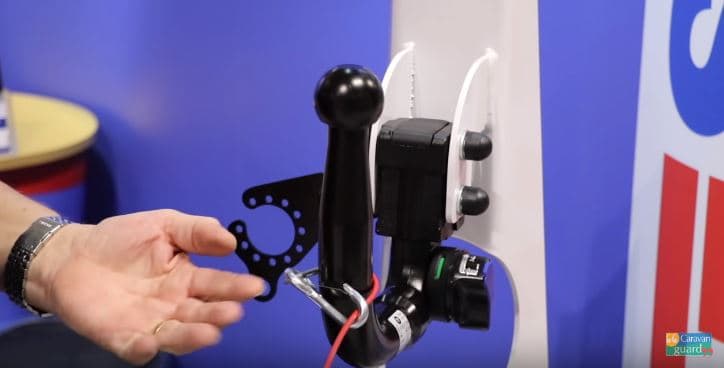
Fitting A Carabiner Breakaway Cable
Now, if your caravan breakaway cable has a carabiner fitting, you have more options. You can follow both the fitment methods above that are suitable for a spring clip cable.
You can also use a permeant mounting point on the car.
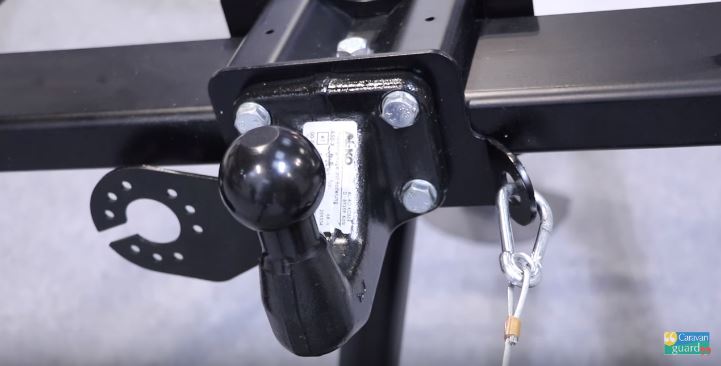
Just to make things confusing, however, some tow cars may appear to have a dedicated mounting point for the breakaway cable, which actually isn’t one.
The image below shows an example of what would appear to be a breakaway cable mounting point. However, its actually not a safe mounting point.
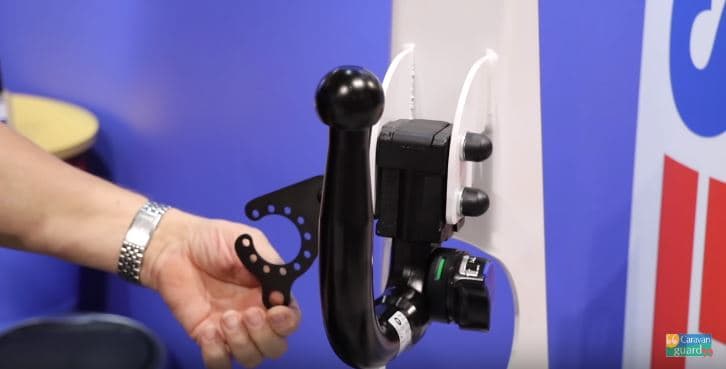
You may be thinking, ‘What’s the difference?‘ Well, there’s actually a big difference between the two.
If you look at the first image, the mounting point is made of much thicker steel, and its truly part of the car’s tow hitch.
The second hole is mounted under the bracket, which supports the cars towing electrical connection. That bracket is made of much thinner steel.
Therefore it may potentially bend and brake off before the breakaway cable engages the caravan handbrake and snaps.
Carabiner Cables – Tow Bar Loop Or Dedicated Bracket Fixing?
If there is a suitable dedicated bracket fixing for your carabiner breakaway cable, it should be preferred over the simple tow ball loop.
Let’s consider the example of your car becoming unhitched for some reason going over a bump. Well, that bump in the road may also bounce the breakaway cable off the tow ball.
Therefore, if you do have a suitable dedicated bracket fixing, you should use it. But again, only if you have a carabiner and not a spring clip.
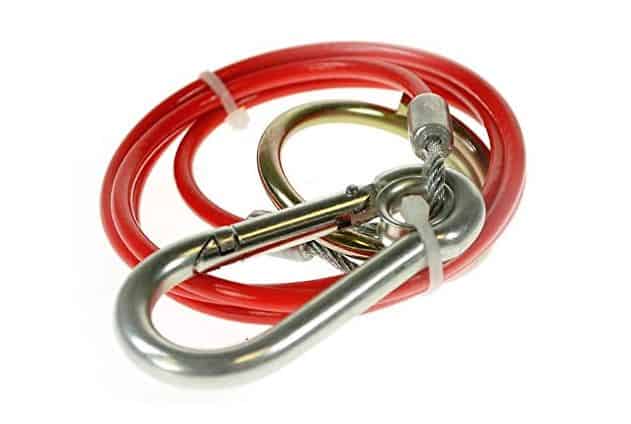
Breakaway Cable Length, Placement & Condition
When it comes to the length of the breakaway cable, you don’t want it to be too tight. First, that will obviously make it more difficult to attach to your car, but it could also cause another issue.
If the breakaway cable is too tight, either making a right or left turn (depending on the cable guide), it could engage your caravan’s handbrake.
Hence, you want the cable to be long enough to avoid this issue, but not so long that it gets caught around other hitch fittings.
Breakaway Cable Guide Loop
For the cable to engage the caravan’s handbrake predictably and reliably, it should be in a straight line and through the guide loop.
If your breakaway cable is outside of this guide loop, you should relocate it through the loop. This will also help to stop the cable from getting damaged.
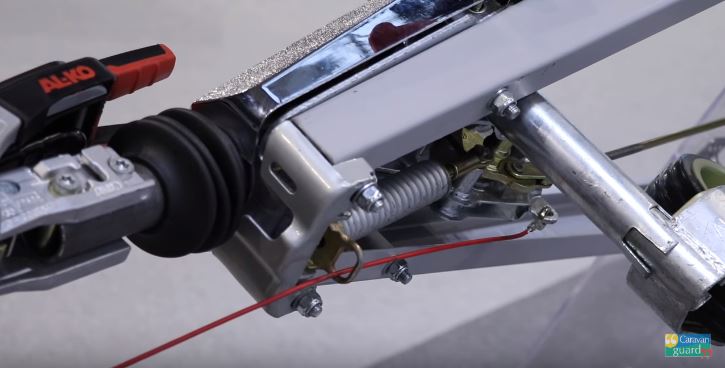
When handling the breakaway cable, if you do find breaks in the plastic outer protection and damaged wire, you should look to replace it. First, handling a broken cable could cause you injury or even a cut.
Secondly, a damaged cable, when required, may snap before it fully engages the caravan handbrake, rendering the purpose of the cable useless.
How To Replace A Breakaway Cable
As discussed above, other than going for a carabiner on your new breakaway in terms of cable length and width (gauge), you want it to be the same as the old cable.
You may need to use a junior hacksaw or similar to cut through the old clip to release it from the caravan handbrake mechanism.
You may be thinking, ‘Why not just a pair of plyers and cut the cable?” You’re welcome to try that method, and if you can do it you’re stronger than I am.
Obviously, a grinder or bolt cutter would also break the cable, but you may not have these tools available.
Some replacement breakaway cables require you to crimp the metal loop back onto itself once fitted to the caravan’s handbrake.
If you do not feel you can achieve this, there are some cables available with a carabiner clip on both ends which maybe be more suitable for you.
Conclusions On Caravan Breakaway Cables
In an ideal world, you will have a tow car with a dedicated breakaway cable mounting point and carabiner cable. This is the new standard.
However, currently, you can legally still use a spring clip cable. But remember, with a spring clip cable, it must only be reattached back onto the cable itself, never a bracket.
Caravan breakaway cables are obviously not the most exciting or interesting of caravanning topics. However, they are an important part of being a legal and responsible caravanner.
Similar topics include making sure your caravan stabiliser is properly maintained and loading your caravan properly.
I hope you learnt something new by reading this post. I also hope you consider coming to visit us here at Horton Common in the near future to try our hardstanding serviced pitches. 🙂
FAQ
Under current UK law, trailers with a weight under 750kg do not require their own braking system. Hence, a breakaway cable would be pointless as there is no handbrake to engage.
If your caravan or trailer has a weight over 750kg, it is against the law not to have a breakaway cable securely fitted between the trailer/caravan and tow vehicle while on UK public roads.
If the car and caravan become unhitched, a properly attached breakaway cable will engage the handbrake on the caravan and then snap.
Therefore, the car is not dragging the caravan. This should then stop the caravan from rolling across the carriageway into the other vehicles or pedestrians.
Typically a breakaway cable fitted to a caravan is designed to snap under the strain of 2 tonnes of force.
However, if you find and fit a breakaway which appears thicker than your current cable, its probably not a suitable replacement.
When it comes to the thickest or gauge of the breakaway cable, you want to choose like for like so the cable will snap instead of dragging the caravan, which would be even more dangerous.
Want To Visit Horton Common? – Book Here


